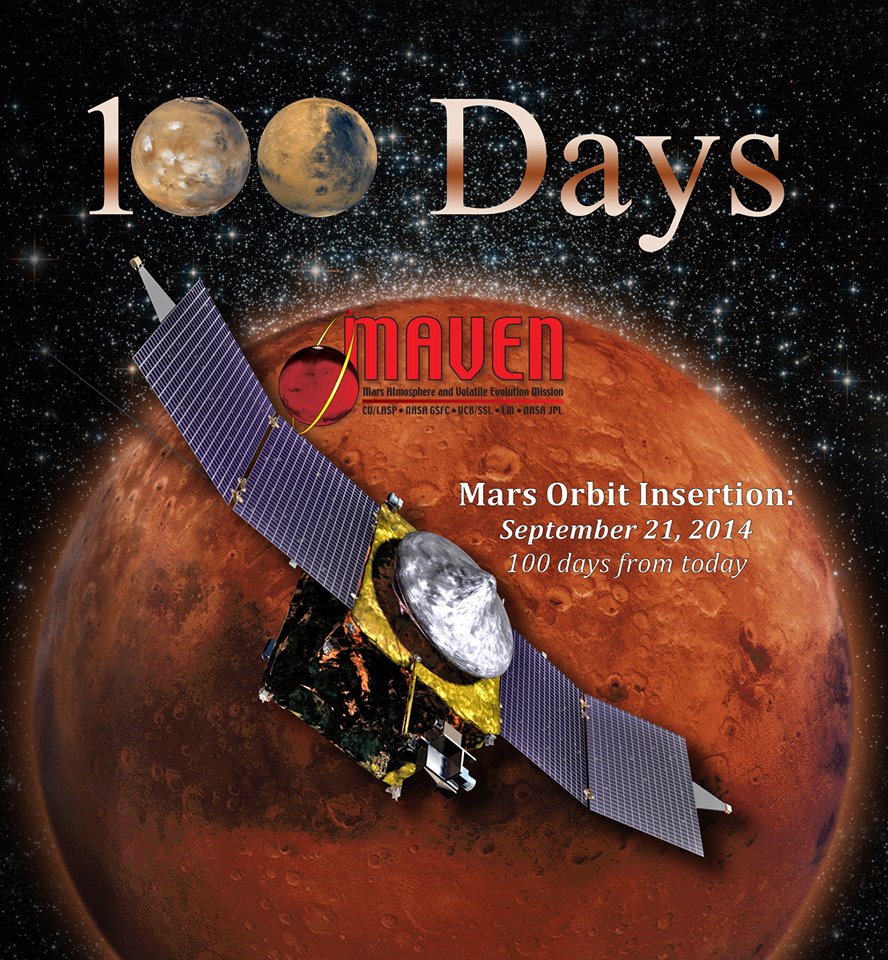
Are you Friggatriskaidekaphobic (suffering from the irrational fear of Friday the 13th)?
Supremely defying any hints of superstition, the fearless team directing MAVEN—NASA’s next orbiter bound for the Red Planet—celebrated this Friday the 13th of June as a noteworthy mission milestone marking just 100 days to the crucial Mars Orbital Insertion (MOI) engine firing scheduled for Sept. 21, 2014.
“Happy Friday the 13th, everyone!” the team excitedly announced.
See above NASA’s cool new mission poster released for the agency’s newest Mars orbiter, the Mars Atmosphere and Volatile Evolution (MAVEN), which will investigate the planet’s thin upper atmosphere and begin solving the riddles of Mars’ climate mysteries, atmospheric loss, and habitability.
“Where did the water go and where did the carbon dioxide go from the early atmosphere? What were the mechanisms?” asks Bruce Jakosky, MAVEN’s Principal Investigator from the University of Colorado at Boulder.
“The spacecraft remains on schedule for Mars orbit insertion on September 21, 2014,” the MAVEN team reports.
As of today, June 15, it’s T-Minus 98 days and counting to MOI!
On June 12, MAVEN was 103,999,786 km (64,622,471 miles) from Earth, with an Earth-centered velocity of 17.0 km/s (10.5 mi/s or 38,000 mph) and a Sun-centered velocity of 23.2 km/s (14.4 mi/s or 51,800 mph).
“I’m delighted that we’re operating in space so well,” Jakosky told me. “We’re on our way!”
Each day it gets 1.4 million km farther away from Earth.
MAVEN has now traveled over 515,271,717 km (320,174,387 miles) on its heliocentric transfer path. The spacecraft is currently less than 26,700,000 km (16,500,000 miles) from Mars.
See MAVEN’s trajectory route map below.
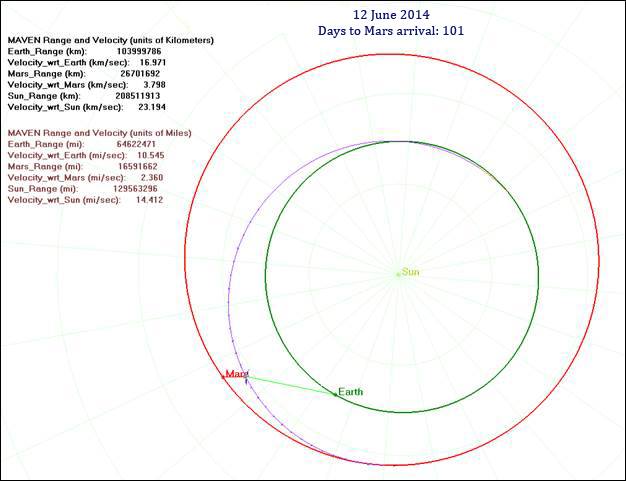
But before MAVEN arrives at Mars, it must first complete a series of five critical Trajectory Correction Maneuvers (TCMs). These thruster firings ensure the craft is aimed on the correct course through interplanetary space.
“The second Trajectory Correction Maneuver (TCM-2) occurred on Feb. 26,” said Jakosky.
TCM-3 is scheduled for July 23.
The $671 Million MAVEN spacecraft’s goal is to study Mars upper atmosphere to explore how the planet may have lost its atmosphere and water over billions of years.
The do-or-die Mars orbital insertion maneuver is slated for approximately 10 p.m. EDT on Sept. 21, 2014, when MAVEN will rendezvous with the Red Planet following a 10-month interplanetary voyage from Earth.
Engineers have designed MAVEN to execute the firing of six orbital insertion thrusters for 38 minutes each to slow and brake the craft into Mars orbit. The 45-pound thrusters will place MAVEN onto an initial 35-hour orbit at a 75-degree inclination. During this phase, the closest point in the orbit to the planet is 236 miles (380 km).
A series of five additional engine burns follows during a five-week “commissioning phase” to maneuver MAVEN into its final 4.5-hour scientific mapping orbit.
Over the course of its one-Earth-year primary mission, MAVEN will observe all of Mars’ latitudes at altitudes ranging from periapsis of 93 miles (150 km) to an apoapsis of more than 3,800 miles (6220 km).
MAVEN will execute five deep dip maneuvers during the first year, descending to an altitude of 78 miles. This marks the lower boundary of the planet’s upper atmosphere.
All of MAVEN’s science instruments were successfully activated by February 2014. Instrument checkouts and calibrations are continuing along the way.
The 5,400-pound MAVEN probe carries nine sensors in three instrument suites to study why and exactly when did Mars undergo the radical climatic transformation.
“I’m really looking forward to getting to Mars and starting our science!” Jakosky told me.
MAVEN’s Imaging UltraViolet Spectrograph (IUVS) captured its first view of Mars on May 21, 2014, at a distance of 35 million km (~22 million miles). It detected the planet and obtained a spectrum of Mars’ sunlit disk in the mid-UV range. See spectrograph below.
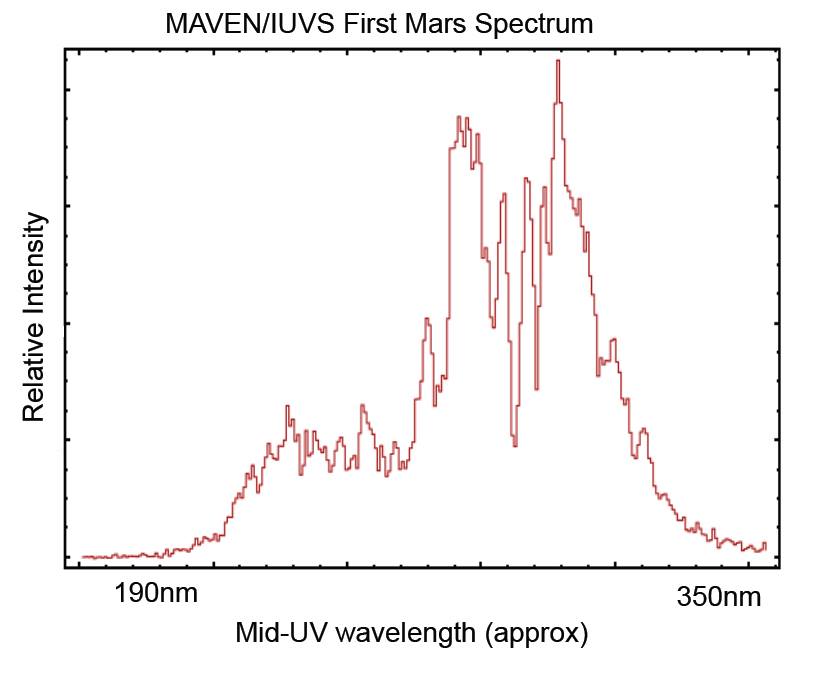
IUVS next measurements are planned soon after MOI.
MAVEN aims to discover the history of water and habitability stretching back over billions of years on Mars. It will answer key questions about the evolution of Mars, its geology, and the potential for the evolution of life.
The science instruments will measure current rates of atmospheric loss to determine how and when Mars lost its atmosphere and water.
“MAVEN is an astrobiology mission,” says Jakosky.
Mars was once wet billions of years ago, but no longer. Now it’s a cold arid world, not exactly hospitable to life.
“We want to determine what were the drivers of that change?” said Jakosky. “What is the history of Martian habitability, climate change and the potential for life?”
MAVEN thundered to space nearly seven months ago on Nov. 18, 2013, following a flawless blastoff from Cape Canaveral Air Force Station’s Space Launch Complex 41 atop a powerful United Launch Alliance Atlas V rocket.
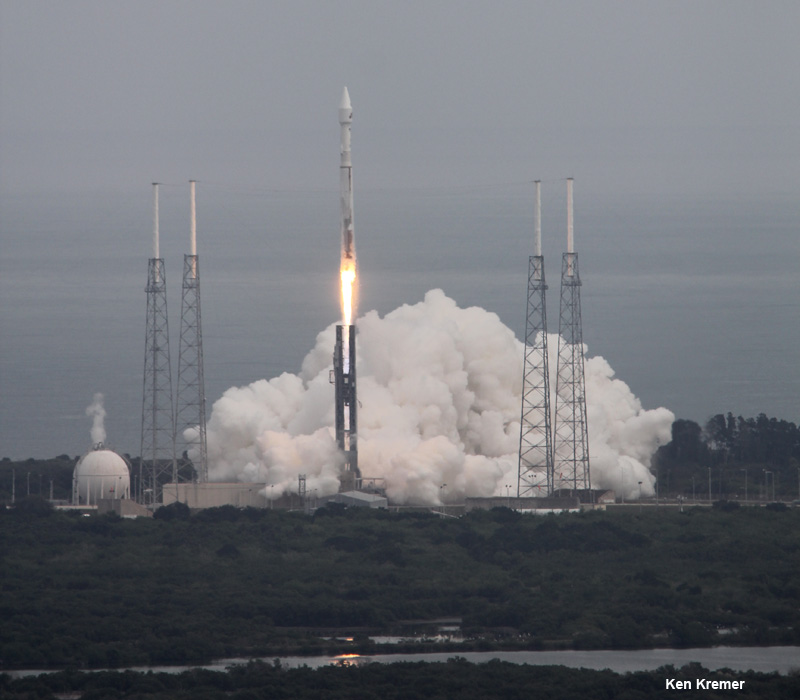
The probe remains on course to join Earth’s invasion fleet at Mars currently comprising three orbiters and two rovers (Curiosity & Opportunity) from NASA and ESA.
MAVEN is not alone in the frigid vacuum of space. She is joined by India’s MOM orbiter likewise in pursuit of Mars. Together they will fortify Earth’s armada to seven spacecraft.
MOM reaches the Red Planets vicinity on Sept. 24, just two days after MAVEN’s arrival.
NASA also recently gave the go-ahead to begin construction of InSight, America’s next Mars lander that will drill far deeper into Mars’ surface than ever before and is due to blastoff in 2016. Read my story here.
Meanwhile, NASA’s one-ton Curiosity rover is trundling across the alien surface inside Gale Crater and capturing stunning new panoramas of towering Mount Sharp and the treacherous sand dunes below.
Mount Sharp is the rover’s ultimate destination, and the team hopes to reach the foothills later this year that lead to the sedimentary rocks at the base of the mysterious mountain which holds clues to the habitability of the Red Planet.
Curiosity said “Farewell Kimberley” after drilling her third bore hole deep into a slab of Martian sandstone and is now analyzing the rock powders cored from the interior.
Scientists from MAVEN, Curiosity, Opportunity, and all the orbiters will work in concert utilizing all the data to elucidate the history of Mars’ potential for supporting life—past and present.
Stay tuned here for continuing developments regarding Earth’s “Missions to Mars.”
Want to keep up-to-date with all things space? Be sure to “Like” AmericaSpace on Facebook and follow us on Twitter: @AmericaSpace
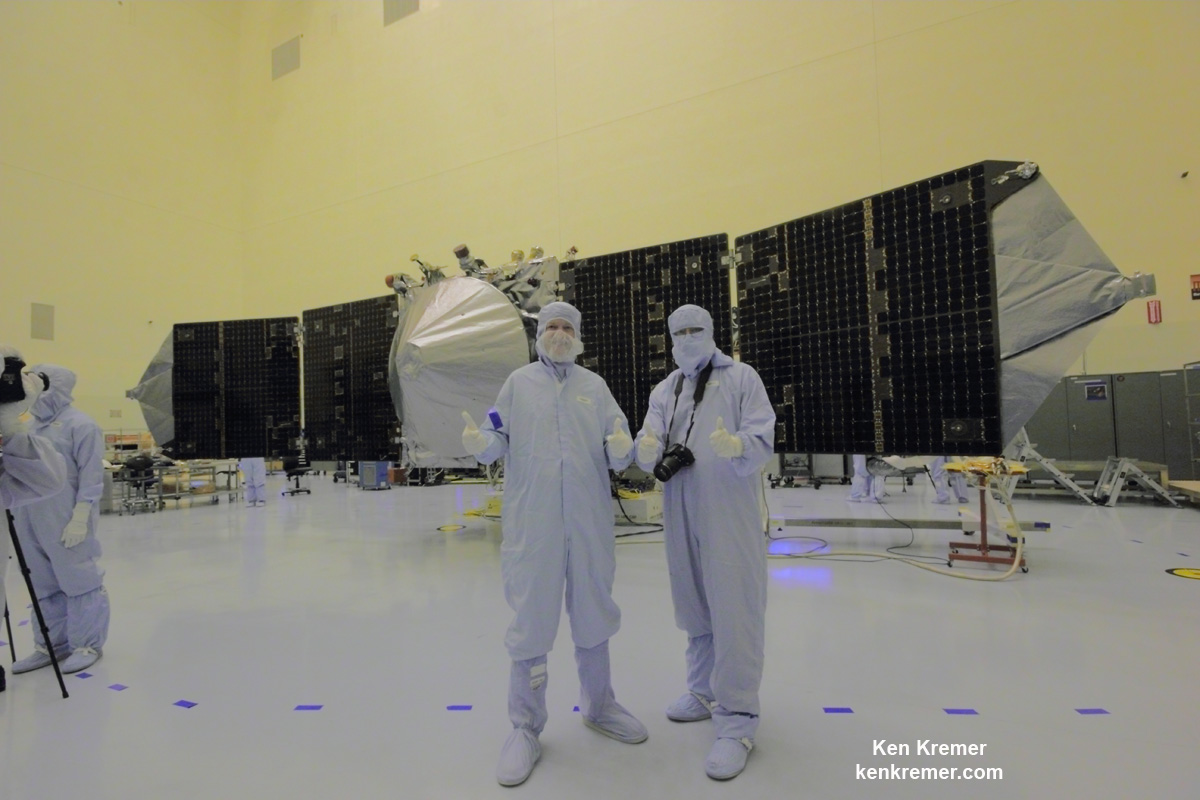




All the very best